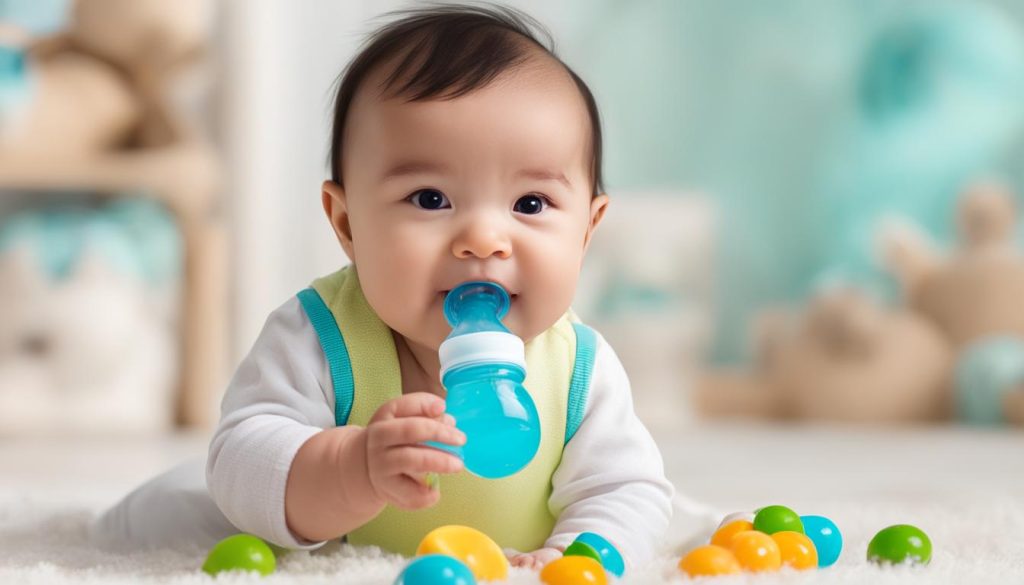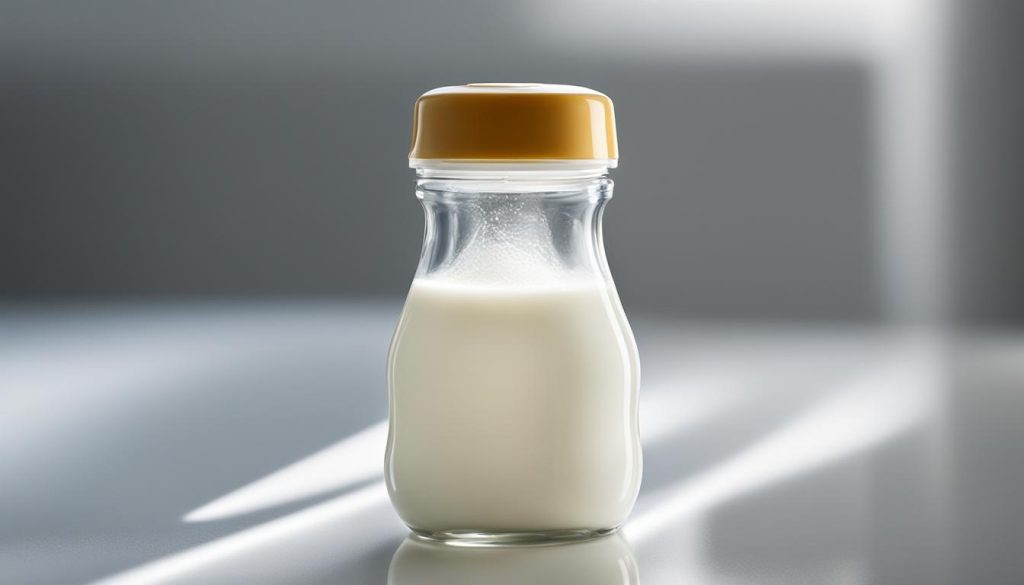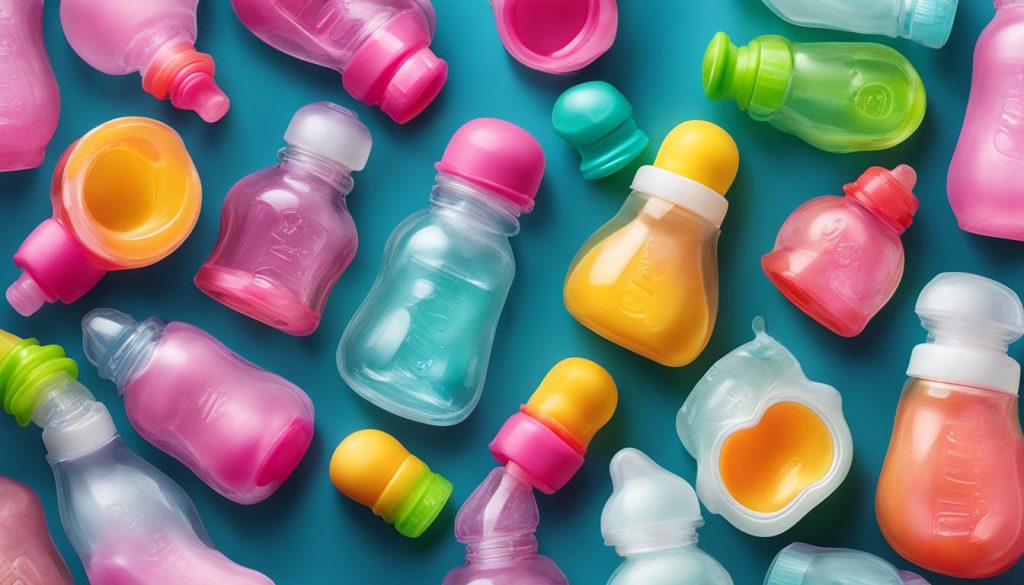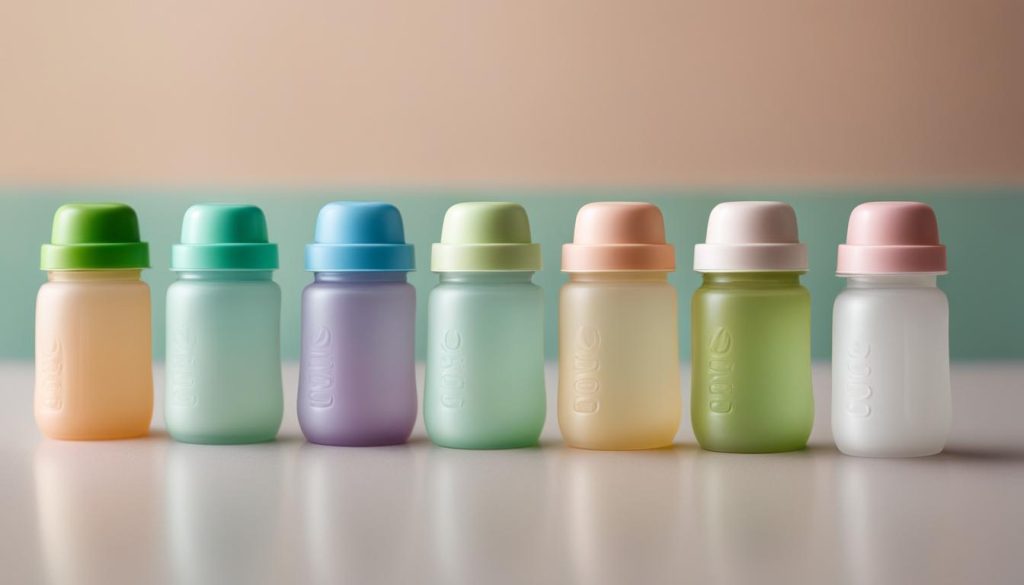When it comes to finding the best bottle for your 8 month old baby, it’s important to consider their unique feeding needs and preferences. After conducting extensive research and gathering insights from thousands of parents, I have identified the top-rated options that provide advanced feeding solutions for your little one.
Based on recommendations from the What to Expect community and our team of testers, the Philips Avent Natural Glass Baby Bottle emerged as the best overall choice. Not only does it offer a natural feeding experience for your baby, but it also provides the durability of a glass bottle. Additionally, other recommended options include the Nuk Simply Natural Baby Bottles, Kiinde System, Tommee Tippee Advanced Anti-Colic Newborn Baby Bottle Feeding Gift Set, Comotomo Baby Bottles, Dr. Brown’s Options+ Baby Bottles, Lifefactory Glass Baby Bottles, and Pura Kiki Stainless Steel Baby Bottles.
When making your decision, it’s essential to take into account important factors such as the material of the bottle, bottle neck width, bottle shape, and nipple size. By considering these factors, you can ensure that your little one has the best possible feeding experience and support their transition from breast or formula feeding to solids.
Stay tuned for the following sections where I will discuss the importance of choosing the right bottle for infant feeding, the different types of baby bottles, tips for bottle maintenance and sterilization, and expert advice on selecting the best bottle for your 8 month old baby.
The Importance of Choosing the Right Bottle for Infant Feeding
Choosing the right bottle for your 8 month old baby is crucial for a successful transition from breast or formula feeding to solids. The right bottle can support your baby’s feeding needs and minimize issues such as colic, gas, and nipple confusion. It is important to consider factors like the material of the bottle (such as glass, plastic, or silicone), the bottle neck width, bottle shape, and nipple size to ensure optimal feeding for your baby.
Infant feeding is a critical stage of your baby’s development, and finding the right bottle can make all the difference. A bottle that is suited to your baby’s needs can help them feel comfortable during feedings and promote healthy digestion. The wrong bottle, on the other hand, can lead to discomfort, fussiness, and feeding difficulties.
When choosing a bottle for your 8 month old, you should consider the material of the bottle. Glass bottles are a popular choice because they are durable, easy to clean, and free from harmful chemicals. Plastic bottles should be BPA-free to ensure your baby’s safety. Silicone bottles offer flexibility and are lightweight, making them a great option for on-the-go feeding.
In addition to the material, bottle neck width, shape, and nipple size can also impact your baby’s feeding experience. Wide-neck bottles are generally easier to clean and can help reduce gas and colic. Different nipple shapes and sizes accommodate various feeding preferences and mimic the shape of a mother’s breast for a more natural feeding experience.
Types of Baby Bottles: Glass, Plastic, and Silicone
When it comes to choosing the right baby bottle for your 8 month old, you have several options to consider. The most common types of baby bottles are glass, plastic, and silicone. Each type has its own unique features and benefits, and it is important to understand the differences between them to make an informed decision.
Glass Baby Bottles
Glass baby bottles are recommended as the best material for baby bottles by the American Academy of Pediatrics (AAP) and the Centers for Disease Control and Prevention (CDC). They are considered to be a safe and eco-friendly choice, as they do not contain any harmful chemicals like BPA or phthalates. Glass bottles are also easy to clean and sterilize, and they are durable enough to withstand high temperatures. Additionally, glass bottles do not absorb odors or flavors, ensuring a fresh and clean feeding experience for your baby.
Plastic Baby Bottles
If you choose to go with plastic baby bottles, it is important to make sure they are made from safe and BPA-free materials. Look for bottles that are labeled as “BPA-free” to ensure that they do not contain any harmful chemicals. Plastic bottles are lightweight and less likely to break than glass bottles, making them a convenient option for on-the-go feeding. However, they may not be as durable as glass bottles and can become scratched over time, which may provide a breeding ground for bacteria.
Silicone Baby Bottles
Silicone baby bottles are a relatively new option in the market. They are made from a soft, flexible material that is safe and free from chemicals like BPA. Silicone bottles are lightweight, easy to clean, and durable. They are also resistant to high temperatures, making them suitable for sterilization. However, some parents find that silicone bottles have a slight odor that can be difficult to remove, and they may not be as widely available as glass or plastic bottles.
| Types of Baby Bottles | Advantages | Disadvantages |
|---|---|---|
| Glass | – Safe and eco-friendly | – Heavier than other options |
| Plastic | – Lightweight and convenient | – Can become scratched and harbor bacteria |
| Silicone | – Soft, flexible, and durable | – May have a slight odor |
Ultimately, the choice between glass, plastic, and silicone baby bottles depends on your personal preferences and priorities. Consider factors such as safety, durability, ease of cleaning, and your baby’s comfort when making your decision. Consult with your pediatrician or other trusted healthcare professionals for additional guidance and recommendations.
Types of Baby Bottle Nipples
Choosing the right nipple for your baby’s bottle is an important decision that can greatly impact their feeding experience. Baby bottle nipples come in different types, each with its own unique features and benefits. Understanding the different nipple types can help you make an informed choice that suits your baby’s needs.
Standard Nipples
Standard nipples are typically included with most baby bottles and are a popular choice for many parents. They have a medium flow rate, making them suitable for babies of different ages. Standard nipples are made of soft silicone and often feature a wide base and a rounded shape, similar to a mother’s breast. These nipples are designed to mimic the natural feel and movement of breastfeeding, making them a good option for babies who switch between breast and bottle feeding.
Variable Flow Nipples
Variable flow nipples are designed to allow the baby to control the milk flow by adjusting the position of their mouth on the nipple. These nipples have a cross-cut or Y-cut opening that can be customized based on the baby’s sucking strength. Variable flow nipples are particularly beneficial for older babies who have developed stronger sucking abilities and need a faster flow rate.
It is important to note that while variable flow nipples offer flexibility, they may not be suitable for newborns or younger babies who are still learning to coordinate their sucking and swallowing reflexes.
Anti-Colic Nipples
Anti-colic nipples are specifically designed to reduce the amount of air your baby ingests during feeding, which can help minimize symptoms of colic, gas, and reflux. These nipples often have vents or valves that allow air to flow out of the bottle, preventing the formation of air bubbles. The reduced air intake can help alleviate digestive discomfort and promote a more comfortable feeding experience for your baby.
When choosing a baby bottle nipple, it is important to consider your baby’s age, feeding abilities, and any specific concerns or preferences they may have. Consulting with your pediatrician or lactation consultant can also provide valuable guidance in selecting the right nipple for your baby’s unique needs.
| Nipple Type | Features | Best Suited for |
|---|---|---|
| Standard Nipples | Soft silicone material, wide base, rounded shape | Babies transitioning between breast and bottle feeding |
| Variable Flow Nipples | Customizable flow rate based on baby’s sucking strength | Older babies with stronger sucking abilities |
| Anti-Colic Nipples | Vents or valves to reduce air intake | Babies prone to colic, gas, or reflux |
Tips for Bottle Maintenance and Sterilization for New Parents
Proper bottle maintenance and sterilization are essential for ensuring the health and safety of your 8 month old baby. As a new parent, it’s important to follow these tips to keep your baby’s bottles clean and free from harmful bacteria.
Bottle Maintenance:
- After each use, wash the baby bottles with warm soapy water. Use a bottle brush to thoroughly clean the inside and outside of the bottles.
- Rinse the bottles thoroughly to remove any soap residue.
- Check the bottles for any signs of wear or damage, such as cracks or scratches. If you notice any damage, replace the bottle immediately.
Bottle Sterilization:
It’s important to sterilize baby bottles to kill any remaining bacteria that may be present.
- Boiling water: Place the bottles in a pot of boiling water for at least 5 minutes. Make sure all parts of the bottle, including the nipples and caps, are fully submerged in the water.
- Steam sterilizers: Use an electric steam sterilizer to safely sterilize the bottles. Follow the manufacturer’s instructions for proper use.
- Microwave sterilizers: Some baby bottles are microwave-safe and can be sterilized using a microwave sterilizer. Again, follow the instructions provided by the manufacturer.
Additional Tips:
Here are a few additional tips to help you maintain and sterilize your baby’s bottles:
“Always make sure to air-dry the bottles completely before storing them. Do not use a towel or cloth to dry them, as this can introduce bacteria. It’s best to place the bottles on a clean drying rack or allow them to air-dry upside down on a clean dish towel.”
Remember to consult with your healthcare provider or pediatrician for specific guidelines on bottle maintenance and sterilization. They can provide personalized advice and answer any questions or concerns you may have.
| Method of Sterilization | Advantages | Disadvantages |
|---|---|---|
| Boiling water | Simple and affordable method | Can be time-consuming |
| Steam sterilizers | Efficient and convenient | Requires an additional appliance |
| Microwave sterilizers | Quick sterilization | May not be compatible with all bottle types |
Note: Always follow the manufacturer’s instructions for sterilization and check for compatibility with your baby bottles before using a specific method.
Expert Advice on Choosing the Best Bottle for an 8 Month Old
When it comes to choosing the best bottle for your 8 month old baby, expert advice can be invaluable in helping you make an informed decision. Pediatricians, lactation consultants, and parenting experts offer valuable insights to ensure that you select a bottle that meets your baby’s unique feeding needs. Here are some expert tips to consider:
1. Material:
Experts recommend choosing a bottle made of glass, plastic, or silicone. Glass bottles are often preferred as they are free from harmful chemicals and provide a hygienic and eco-friendly option. However, plastic bottles should be BPA-free to ensure the safety of your baby. Silicone bottles offer durability and flexibility, making them a popular choice as well.
2. Bottle Neck Width and Shape:
The width of the bottle neck can impact ease of cleaning and assembling. Wide neck bottles are generally easier to clean and allow for easy formula or breast milk transfer. The shape of the bottle is also important as it can enhance your baby’s grip and feeding experience. Some bottles feature ergonomic designs and anti-slip textures to promote self-feeding as your baby grows.
3. Nipple Size and Type:
Choosing the right nipple size and type is crucial for your baby’s comfort and feeding abilities. Nipple flow rates vary, and it’s important to select a flow rate suitable for your baby’s age and feeding pace. Nipples with different shapes and textures are available, some designed to mimic the feel of a mother’s breast. Consulting with a healthcare professional can help you determine the best nipple type for your baby.
Expert Tip: “Always consider your baby’s preferences and feeding style when choosing a bottle. Keep in mind that what works for one baby may not work for another. Don’t be afraid to try different options until you find the perfect fit.”
4. Consider Your Baby’s Unique Needs:
Every baby is different, and it’s important to take into account any specific feeding needs your baby may have. For example, if your baby experiences colic or gas, you may want to choose a bottle with anti-colic features such as venting systems or collapsible bags. Assessing your baby’s individual requirements will help guide your decision-making process.
By following expert advice and considering factors like material, bottle neck width, shape, and nipple size, you can choose the best bottle for your 8 month old. Remember, there is no one-size-fits-all solution, so be prepared to try different options until you find the bottle that best suits your baby’s needs.
Conclusion: The Best Bottle for Your 8 Month Old
After extensive research and considering recommendations from parents, expert opinions, and community polls, the best bottle for an 8 month old is the Philips Avent Natural Glass Baby Bottle. This bottle offers a combination of features that make it ideal for your baby’s feeding needs.
While the Philips Avent Natural Glass Baby Bottle emerged as the top choice, there are other excellent options available as well. These include the Nuk Simply Natural Baby Bottles, Kiinde System, Tommee Tippee Advanced Anti-Colic Newborn Baby Bottle Feeding Gift Set, Comotomo Baby Bottles, Dr. Brown’s Options+ Baby Bottles, Lifefactory Glass Baby Bottles, and Pura Kiki Stainless Steel Baby Bottles.
When selecting the best bottle for your 8 month old, it is important to consider factors such as material, bottle neck width, bottle shape, and nipple size. Each baby is unique, and finding the right bottle that suits your baby’s preferences and minimizes feeding issues like colic and gas is crucial.
Remember, the transition from breast or formula to solids is an important milestone for your baby, and choosing the best bottle can support a smooth transition and enjoyable feeding experience for both you and your little one.
FAQ
What is the best bottle for an 8 month old?
According to a poll of over 1,500 parents in the What to Expect community and testers from the What to Expect staff, the best baby bottle for an 8 month old is the Philips Avent Natural Glass Baby Bottle. Other top options include the Nuk Simply Natural Baby Bottles, Kiinde System, Tommee Tippee Advanced Anti-Colic Newborn Baby Bottle Feeding Gift Set, Comotomo Baby Bottles, Dr. Brown’s Options+ Baby Bottles, Lifefactory Glass Baby Bottles, and Pura Kiki Stainless Steel Baby Bottles.
What factors should I consider when choosing a bottle for my 8 month old?
When choosing a bottle, it is important to consider factors such as material, bottle neck width, bottle shape, and nipple size.
What are the different types of baby bottles available?
There are different types of baby bottles available, including glass, plastic, and silicone.
Which type of baby bottle is recommended by experts?
Glass bottles are recommended as the best material for baby bottles by the American Academy of Pediatrics (AAP) and the Centers for Disease Control and Prevention (CDC).
How do I choose the right nipple for my 8 month old baby?
Baby bottle nipples come in different shapes, sizes, and flow rates. It is important to choose the right nipple for your 8 month old baby to ensure comfortable and efficient feeding.
How should I maintain and sterilize baby bottles?
It is recommended to wash baby bottles with warm soapy water after each use and to thoroughly rinse them to remove any soap residue. Bottles can be sterilized using boiling water, steam sterilizers, or microwave sterilizers.
Where can I find expert advice on choosing the best bottle for my 8 month old?
Pediatricians, lactation consultants, and parenting experts provide valuable advice on choosing the best bottle for an 8 month old. It is recommended to consult with healthcare professionals or parenting resources.




